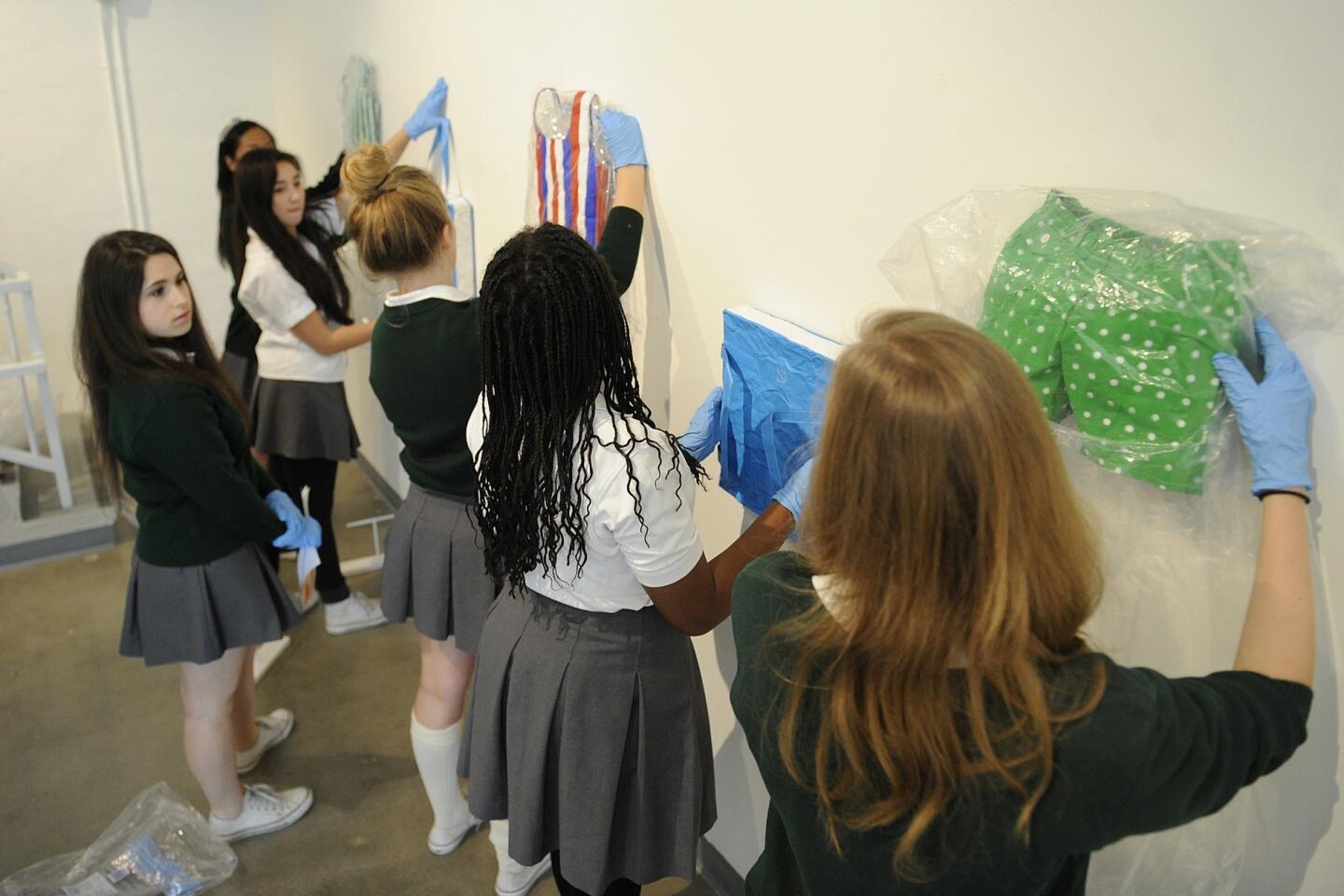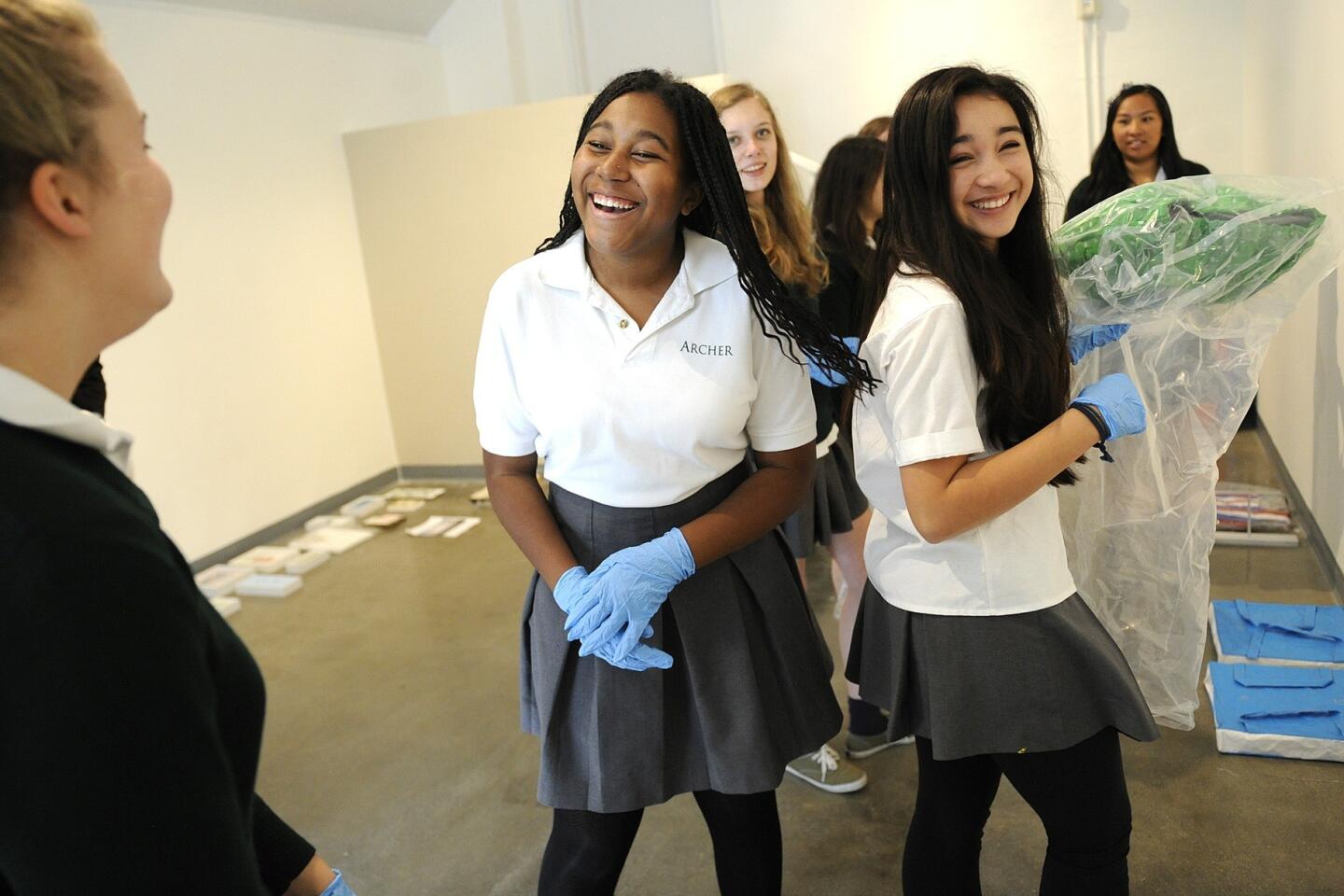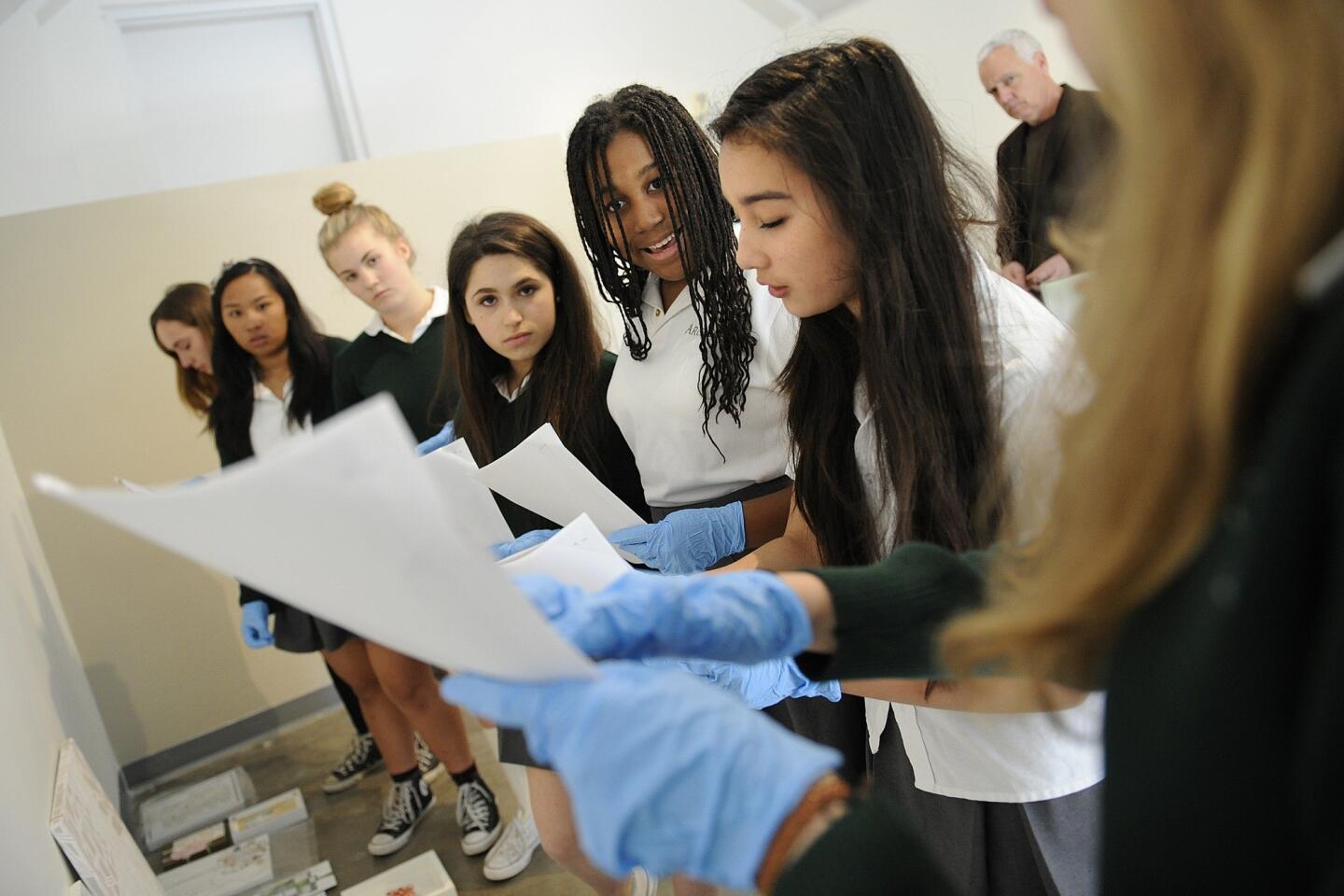Teen curators learn the art of gallery management at girls’ school
- Share via
It was a knotty problem that many curators face at some point in their careers: making sure a three-artist exhibition doesn’t look like three completely distinct shows in one space.
“We need to find a way to connect the artwork; it should flow from one wall to another,” said one curator, who wore disposable blue gloves as she carefully held up a painting.
“What if we use these images of trees side by side, so the green works as a transition?” asked another, moving an artwork closer to a corner.
But in this case the curators don’t really have careers — yet.
The blue gloves worn by these art handlers offset the green V-neck sweaters and gray pleated skirts of their school uniforms. They are teenagers at the Archer School for Girls in Brentwood who are completing their school’s first-ever class in “gallery management and design,” which involves running the school’s art gallery from organizing exhibitions to hosting opening-night events.
Museum and curatorial programs are more common at the university level, but a high school art gallery is unusual — and a student-run gallery even more rare. Archer’s program, which evolved from a popular school club into a for-credit course this year, is also winning praise from local gallery owners.
“You never know. One of these girls might be the next Ann Philbin,” said gallerist Peter Fetterman, referring to the director of the Hammer Museum.
Fetterman lent photographs from his book “Woman: A Celebration” for a 2008 show at the school gallery. One of his daughters graduated from the school, and the two interns at the gallery have come from Archer.
Archer’s spring exhibition featured three female artists: Phranc, Pam Posey and Nancy Monk. It took place in the campus gallery, a converted chapel originally built in the 1930s. All three artists show with the Santa Monica gallery of Craig Krull, who has two daughters at the school.
“It’s a good way to raise money for the school,” he said. “I worked with them in 2007 on Julius Shulman and Peter Alexander, a two-person show that raised $75,000 for the school.” (He and Shulman donated their proceeds from sales to the school.)
Phranc’s work in the show consisted of paper sculptures painted to look like colorful beach gear: bright green swimsuits, blue boat cushions and a green-yellow-and-red striped sunbrella included. Posey’s paintings were delicate watercolor images of trees done on scraps of hardwood such as oak and maple. Monk works with photographs and found materials such as dish towels and buttons to create intricately patterned, sometimes pixelated-looking mixed-media paintings, often with a branching or flowering form.
The seven students in the gallery class chose these artists after a scouting trip this year to Bergamot Station, where they visited galleries looking for art. Krull showed them works by several artists, but the group gravitated toward these three women.
And all of the students played a role in hanging the artworks. They spoke over one another, reached over one another, and finished one another’s sentences during a 20-minute whirlwind of deciding where to place which works.
They finished Monk’s wall quickly, doing a crowded, salon-style hang of small patterned pieces clustered around a few larger works, including the one made with a stretched dish towel. “Let’s put the dish towel at eye level, so you can really see what it is,” said Sage Malecki, 17.
Their biggest challenge was figuring out how to group Phranc’s beach-themed sculptures. They quickly agreed to put the umbrella sculpture in the corner, and to bring in real sand for it. But they weren’t as sure about where to position a pair of faux boat cushions and tried out different options in rapid-fire succession.
“Do you think this works on the wall?” asked Danielle Simpson, 17.
“It’s a seat — do we want to keep the seats together?” said Seaf Hartley, 15.
“You know what would be really cute, if we put the two seats together with a swimsuit here and the trunks there, it would look like two people coming together,” said Carina Oriel, 14.
“That would be so cute, I think people will get the idea of two people sitting together,” said Riel Macklam, 17.
Then, after a minute, the idea evolved.
“Do we want the cushions together, because that would be just one pedestal instead of two separate ones?” said Shelby Mumford, 14.
“What if you hang the cushions on the wall?” said Simpson.
“I think that would be cool,” said Siena Deck, 15. “What do you think: are they sturdy enough to go on the wall?”
“That’s a good idea. I think we could hang them, but we will have to ask Phranc,” said Krull.
“Maybe we could put something on the wall to support them,” said Deck.
“They look like little backpacks,” said Hartley.
The course’s teacher, Patti Meyers, said the hubbub was the norm at Archer. “It’s interesting to see how polite and collaborative they are with each other — they are always making suggestions and asking questions, instead of saying: ‘No, let’s do it this way, my way.’ And then out of all of the voices and ideas, some ideas will become stronger and decisions will get made.”
(In the case of the boat cushions, the students ultimately nixed the idea of hanging them on the wall because of their fragility and propped them up against the wall on a shelf instead.)
The gallery course has roots in a school club that was founded in 2006 by teacher Patti Marcus, who is now retired but helped out this month as a juror of the current student art exhibition. The first show featured work by actor-turned-artist Leonard Nimoy, lent by his gallerist Louis Stern.
The program became a class in 2012. Meyers said she lobbied for accreditation because of the time involved. “As a club, we could make a list of what we needed to do, but I ended up doing a lot of the work.”
Now, she said, the kids do everything from selecting artists to designing exhibition posters. Some enjoy making art, such as program alumni Isabella Huffington (daughter of Arianna and a Yale student who has her own website showcasing her art portfolio) and Dannielle Bowman, who recently completed her degree in fine art at Cooper Union in New York. Others say they are drawn to the business and marketing side.
“We don’t all necessarily want to be curators when we grow up,” said Hartley, whose title is gallery director. “But if we become entrepreneurs or COOs of companies, we would use the same skill set of communicating and collaborating.”
Archer head Elizabeth English said the gallery program, like the school’s student-run film festival, is designed to emphasize hands-on learning. “All of these programs share some overarching objectives, like preparing women for positions of leadership.”
Simpson said she liked the adult-like responsibilities. “It’s very cool: You run a gallery, you sell art, it’s like being a professional.” Her title is hospitality director. Translation? “I plan gallery food and events,” she said.
Oriel, director of marketing, said she never realized how many phone calls go into planning an exhibition. “For this past show we worked a lot on publicity — sending out 10 emails a day and not getting responses. I didn’t realize how hard it could be.”
Mumford has learned something about the art of closing a sale, having sold three works from a 2012 show done in collaboration with the boys’ school Loyola. “We created these works by spray painting a whole collage of galaxies — they were really, really awesome looking,” she said.
She also sold a work from last year’s installation of the Greek-American artist Dianne Pappas to Krull, who bought a work for himself and also took a small sculpture of hers on consignment to show in his Bergamot Station gallery. Pappas’ work, which he describes as small hand-held, mathematical-inspired constructions “that recall dominoes, dice and cellphones,” went on display in a gallery vitrine.
“I had never heard of her before the Archer show,” Krull said. “Not only am I bringing the students work, they are bringing it to the larger art world.”
What: Exhibit of student artwork from grades 9 to 12
Where: The Archer School for Girls, 11725 Sunset Blvd., Los Angeles
When: By appointment through Sept. 1
Information: info@archer.org or (310) 873-7000
More to Read
The biggest entertainment stories
Get our big stories about Hollywood, film, television, music, arts, culture and more right in your inbox as soon as they publish.
You may occasionally receive promotional content from the Los Angeles Times.














